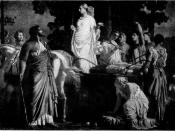In Bryan Singer's 1995 film "The Usual Suspects," the fine art of storytelling is utilized in order to give the storyteller power. The narrator, who is appropriately named Verbal, weaves a web of words, drawing his audience into his story. This not only gives him the power over what his audience is thinking, but it also established the narrator as a friend, someone who can be trusted. In "The Usual Suspects," the narrator is a crippled, powerless man who is the only survivor of a huge criminal operation. As far as the Detective knows, he is the only man with the "real story" who can give them the truth. The art of storytelling is also used by everyone's favorite trickster, Odysseus. Like Odysseus, Verbal employs the means of storytelling to improve his position.
The Odyssey begins in the middle, or in media res, and slowly we are caught up to real time and find out where Odysseus really is.
Similarly, in "The Usual Suspects," the story is told as a series of flashbacks, intertwined with real-time police interrogations with Verbal. The plot is cleverly crafted to go around in a loop, with the ending ultimately being at the start, making the audience slowly piece together clues and imagery, a little at a time, to understand the relatively complex structure of the film. There are constant intertwining scenes from the past and the present, only letting the audience learn bit-by-bit, like the detective's state of mind. The director of the film himself is also a storyteller, using voiceovers to avoid tedious elements of the plot, which are observable in many modern day films. Due to Singer's skilled storytelling, character and plot developments are achieved quickly, and no sacrifice of pace is conceded, thus...


